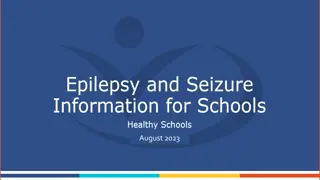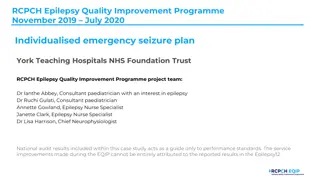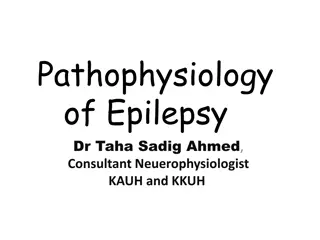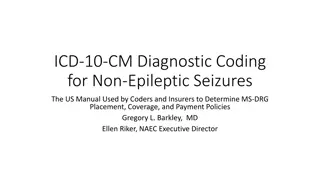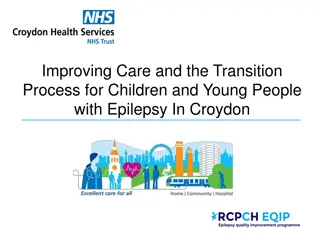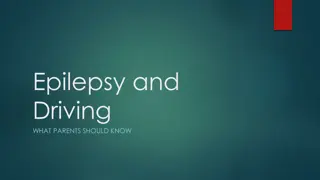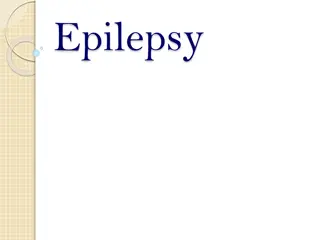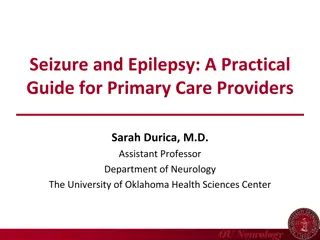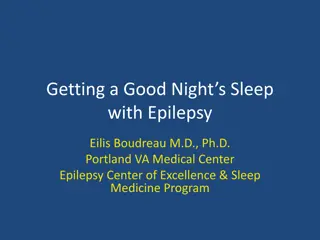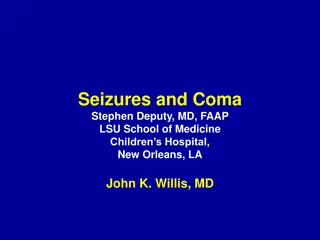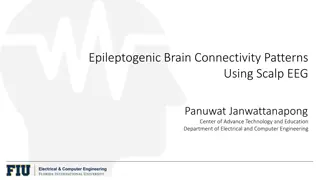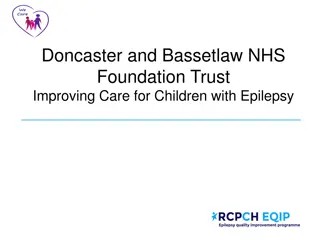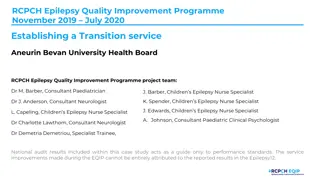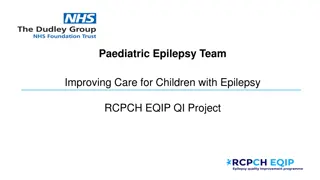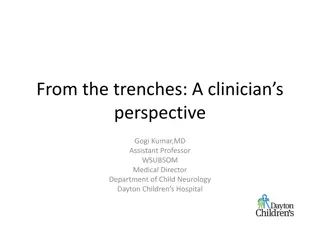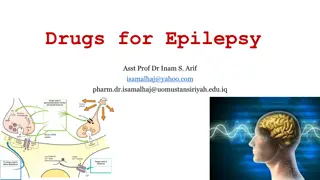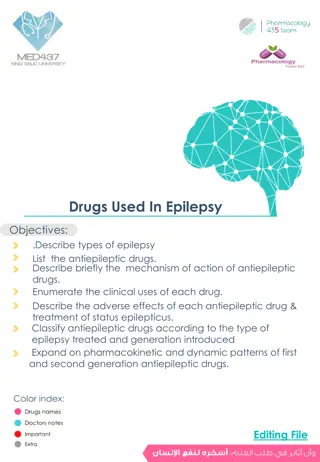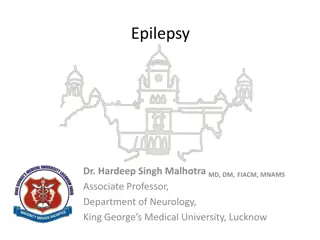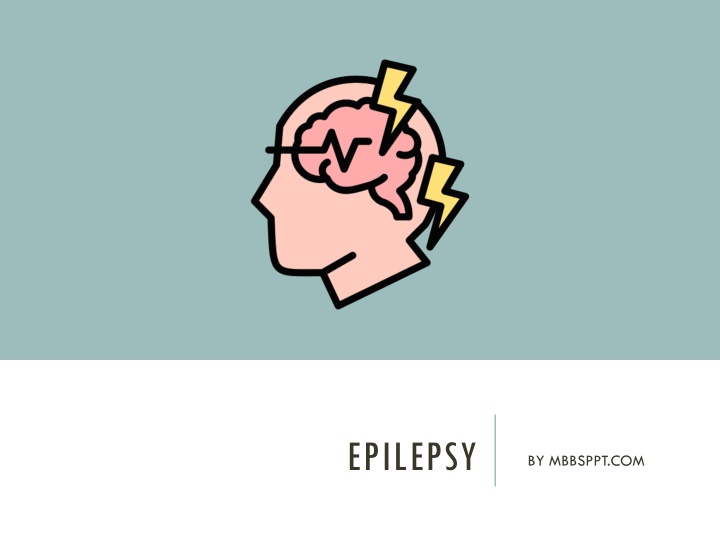
Seizures and Epilepsy: Causes and Symptoms
Seizures, temporary disruptions of brain function, can be caused by various medical conditions and neurological factors. Epilepsy, a chronic condition, involves recurrent seizures of varying intensity. Learn about the causes, symptoms, and classification of epileptic seizures, such as focal seizures originating in specific brain regions. Explore how neuronal activity, neurotransmitters like glutamate and GABA, and brain lesions play a role in seizure development.
Download Presentation

Please find below an Image/Link to download the presentation.
The content on the website is provided AS IS for your information and personal use only. It may not be sold, licensed, or shared on other websites without obtaining consent from the author. If you encounter any issues during the download, it is possible that the publisher has removed the file from their server.
You are allowed to download the files provided on this website for personal or commercial use, subject to the condition that they are used lawfully. All files are the property of their respective owners.
The content on the website is provided AS IS for your information and personal use only. It may not be sold, licensed, or shared on other websites without obtaining consent from the author.
E N D
Presentation Transcript
EPILEPSY BY MBBSPPT.COM
SEIZURE AND EPILEPSY Seizures are temporary disruptions of brain function caused by uncontrolled excessive neuronal activity. The temporary symptomatic seizures usually do not persist if the underlying disorder is corrected. They can be caused by multiple neurological or medical conditions, such as acute electrolyte disorders, hypoglycemia, drugs (e.g., cocaine), eclampsia, kidney failure, hypertensive encephalopathy, meningitis, and so forth. In contrast to symptomatic seizures, epilepsy is a chronic condition of recurrent seizures that can also vary from brief and nearly undetectable symptoms to periods of vigorous shaking and convulsions.
SEIZURE AND EPILEPSY During a seizure clusters of neurons in brain become temporarily impaired and starts to send out many excitatory signals over and over again. The main excitatory signal in brain is glutamate and NMDA is its primary receptor. Patients with epilepsy have fast or long-lasting activation of these receptors. On the other side main inhibitory neurotransmitter in brain is GABA which binds to GABA-receptors and inhibit the neuronal signals by letting Chloride ions in. Some patients with epilepsy can have genetic mutation in which GABA- receptors becomes dysfunctional and so they are unable to inhibit signals.
SEIZURE AND EPILEPSY These receptors and ion channels can also be affected by brain tumors, brain injury or infections. Whether it is decrease in inhibition or increase in excitation it is often noticed by others as obvious outward signs like jerking, moving or losing consciousness. But it can also be subjective experience that can only be noticed by patient like fear or strange smells. It all depends upon which neurons in brain are affected.
CLASSIFICATION OF EPILEPTIC SEIZURE
FOCAL OR PARTIAL SEIZURE Focal epileptic seizures begin in a small localized region of the cerebral cortex or deeper structures of the cerebrum and brain stem and have clinical manifestations that reflect the function of the affected brain area. Most often, focal epilepsy results from some localized organic lesion or functional abnormality, such as: Scar tissue in the brain that pulls on the adjacent neuronal tissue. A tumor that compresses an area of the brain. A destroyed area of brain tissue.
FOCAL OR PARTIAL SEIZURE These lesions can promote extremely rapid discharges in the local neurons; when the discharge rate rises above several hundred per second, synchronous waves begin to spread over adjacent cortical regions. These waves presumably result from localized reverberating circuits that may gradually recruit adjacent areas of the cortex into the epileptic discharge zone. The process spreads to adjacent areas at a rate as slow as a few millimeters a minute to as fast as several centimeters per second. Focal seizures can spread locally from a focus or more remotely to the contralateral cortex and subcortical areas of the brain through projections to the thalamus, which has widespread connections to both hemispheres. When such a wave of excitation spreads over the motor cortex, it causes a progressive march of muscle contractions throughout the opposite side of the body, beginning most characteristically in the mouth region and marching progressively downward to the legs but at other times marching in the opposite direction. Tis phenomenon is called Jacksonian march.
FOCAL OR PARTIAL SEIZURE Focal seizures are often classified as: Simple partial when there is no major change in consciousness or as Complex partial when consciousness is impaired. Simple partial seizures may be preceded by an aura, with sensations such as fear, followed by motor signs, such as rhythmic jerking or tonic stiffening movements of a body part. Complex partial seizures may also begin with an aura followed by impaired consciousness and strange repetitive movements (automatisms), such as chewing or lip smacking. After recovery from the seizure the person may have no memory of the attack, except for the aura.
GENERALIZED EPILEPTIC SEIZURES Generalized epileptic seizures are characterized by diffuse, excessive, and uncontrolled neuronal discharges that at the outset spread rapidly and simultaneously to both cerebral hemispheres through interconnections between the thalamus and cortex. However, it is sometimes difficult clinically to distinguish between a primary generalized seizure and a focal seizure that rapidly spreads.
CLASSIFICATION OF GENERALIZED SEIZURE Tonic seizure: Muscles becomes stiff and flexed which cause patients to fall generally backwards. Atonic: Muscles relax and become and floppy which allows patients to fall forward. Clonic: Characterized by violent muscle contraction also known as convulsions. Myoclonic: Characterized by short muscle twitches, sometimes single twitch and sometimes as many twitches in short period of time. Absence Seizure: Patient lose consciousness and then quickly regain it. It looks that the person is spaced out. Tonic-clonic seizure: These are most common where patient experience a tonic phase when muscles suddenly tense up followed by clonic phase when muscles rapidly contract and relax.
If seizures last over longer period of time like over 5 mins of ongoing seizures or having multiple seizures without returning to normal then it is called Status Epilepticus and are usually tonic-clonic types but can also be caused by other types that don t involves convulsions. It is considered as medical emergency and can be life threating if not treated immediately. Following seizures patients experience some symptoms like confusion called postictal confusion. Paralysis in arms or legs that is limited to 1 side of body and is known as Todd s Paralysis. It can be up to 15 hrs. long, maybe due to temporary and severe separation of seizure affected area.
DIAGNOSIS Diagnostic Methods are: MRI & CT which look for abnormalities like tumors EEG detects electrical signals of brain. Epilepsy varies person to person diagnosis requires test and examination of patient s history.
TREATMENT Treatment Includes: Anticonvulsants or drugs that enhance the Effect of GABA. Epilepsy surgery: Removal of cause of seizure. Nerve stimulation like stimulation of Vagus nerve which influences neurotransmitter release. Ketogenic Diet which forces Body to burn fat & produces ketone bodies which are then used by brain as energy source instead of Glucose.

